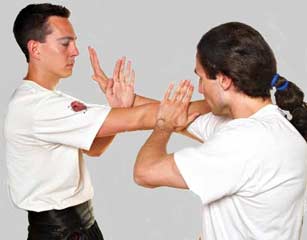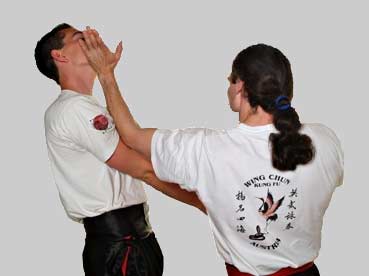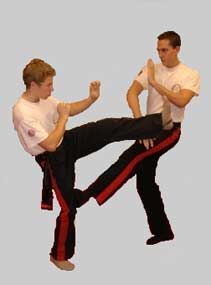 Description: Wing Chun is arguably the most famous single style within the Shaolin system. It was made known to the west by Bruce Lee and James Lee in the late 1960s in what was the single most influential introduction of Chinese Kung Fu outside China (one might equate Bruce Lee's bringing of kung fu to American television in 1964 with the arrival of the Beatles in America two years earlier). Despite Lee's rapid evolution of a personal style away from traditional Wing Chun, his association with that style was a major factor in its continued success over the years. More recently, the style has received new publicity following the death of long time grandmaster Yip Man as at least three of his senior disciples have waged an acrimonious conflict over who would inherit the supreme mantle for the style.
Description: Wing Chun is arguably the most famous single style within the Shaolin system. It was made known to the west by Bruce Lee and James Lee in the late 1960s in what was the single most influential introduction of Chinese Kung Fu outside China (one might equate Bruce Lee's bringing of kung fu to American television in 1964 with the arrival of the Beatles in America two years earlier). Despite Lee's rapid evolution of a personal style away from traditional Wing Chun, his association with that style was a major factor in its continued success over the years. More recently, the style has received new publicity following the death of long time grandmaster Yip Man as at least three of his senior disciples have waged an acrimonious conflict over who would inherit the supreme mantle for the style.

History: About two hundred years ago, there lived in China a beautiful young woman whose name was Yim Wing Chun. Her name suited her admirably, since it meant "Beautiful Springtime." She was the daughter of a food merchant, who sold beancurd from a marketstand. She was betrothed to the man she loved, Leong Bok Chao. Her father, however, could not resist boasting of her beauty and gentle character.
One day, news of this beautiful maiden came to the ears of an infamous warlord of the Yunan province. He journeyed to her town, and upon seeing her, was immediately struck with a consuming desire to possess her, and, as often the way with rogues, decided to get his way by force. He ordered Wing Chun's father to his camp and told him that unless the maiden was given to him in marriage, he would kill them both. The father, his heart full of fear and confusion, and horrified at the warlord's cruel tactics, left the warlord's encampment to return home to tell his lovely daughter of her fate. There seemed to be no alternative, since the rogue was well known for his brutal atrocities and powerful gang of bandits. Calling young Wing Chun to him, the father told her of the warlord's ultimatum.
"Your name will be honored in our family and you will be esteemed as a revered ancestor", he said, struggling for words to make the idea more palatable. "Who knows, you may be able to soften the warlord's heart and maintain yourself with pride as his wife, if not with the love I know you have for Leong Bok Chao.
 Ng Mui was a Shaolin nun, who had lived for many years in the great southern temple of Fukien. Some years earlier, this refuge of the contemplative life had been destroyed during a rebellion against the Manchu dynasty. Ng Mui was one of the few that had escaped the holocaust. She was an adept of the Shaolin fighting arts of dragon and crane. These arts had been developed to allow the priests and nuns to protect themselves from wild animals and wilder men, who would seek to destroy the peaceful way of the Shaolin order.
When Ng Mui heard of the dilemma that Wing Chun found herself in, the nun sat quietly in meditation, thinking of a way which, in accord with Shaolin principles, would cause the least pain and hurt to all.
Ng Mui was a Shaolin nun, who had lived for many years in the great southern temple of Fukien. Some years earlier, this refuge of the contemplative life had been destroyed during a rebellion against the Manchu dynasty. Ng Mui was one of the few that had escaped the holocaust. She was an adept of the Shaolin fighting arts of dragon and crane. These arts had been developed to allow the priests and nuns to protect themselves from wild animals and wilder men, who would seek to destroy the peaceful way of the Shaolin order.
When Ng Mui heard of the dilemma that Wing Chun found herself in, the nun sat quietly in meditation, thinking of a way which, in accord with Shaolin principles, would cause the least pain and hurt to all.
Wing Chun Martial Approach: There are two concepts that are essential to Wing Chun: centerline and simplicity. The centerline is guarded meticulously with hands on center and elbows down and in. Movement is small and extremely efficient, utilizing subtle shifts of the body to deflect, evade and counterstrike all in one motion. At its most advanced level, contact with the opponent is maintained at all times to constantly check arms and legs, trap, and utilize the opponent’s movement to guide and even to increase power. Once the first blow is struck, the Wing Chun practitioner will march an opponent back with a constant barrage of swift, low kicks to disrupt the stance, and a flurry of cycle punches that serve as both offense and defense, batting everything off center and continuing in for the strike. Because of its simplicity, Wing Chun can be used effectively by beginning practitioners; also because of its simplicity, at its most advanced, Wing Chun is a devastatingly efficient style.

3 comments:
Most people are surprised to discover that most Kung Fu was preserved for history by the actors of Beijing Opera. The real monks were killed a century ago! A few survived, and found work in Peiking teaching actors because of course, then as now, the general populace liked watching stories about those great fighters and spiritual role models.
Peiking Opera has survived just fine though. Many movies have been made in the multi-level, multi stage over the top style of Peking Opera...most notably Hero.
My art is not Kung Fu, of course, or even Tai Chi...though I love to watch both. I teach heavy broadsword fighting and Kenjuitsu. I try to steal as much as possible from other arts though. It will be a long time before I will be light enough on my feet to be able to fight across the surface of a still water lake like they did in "Hero".
The monks you see on tour are are employed by the state to promote Chinese tourism, and they are not opera actors or real monks.
COOL!
No Dude, you are the cool one for putting up so many cool posts!
Post a Comment